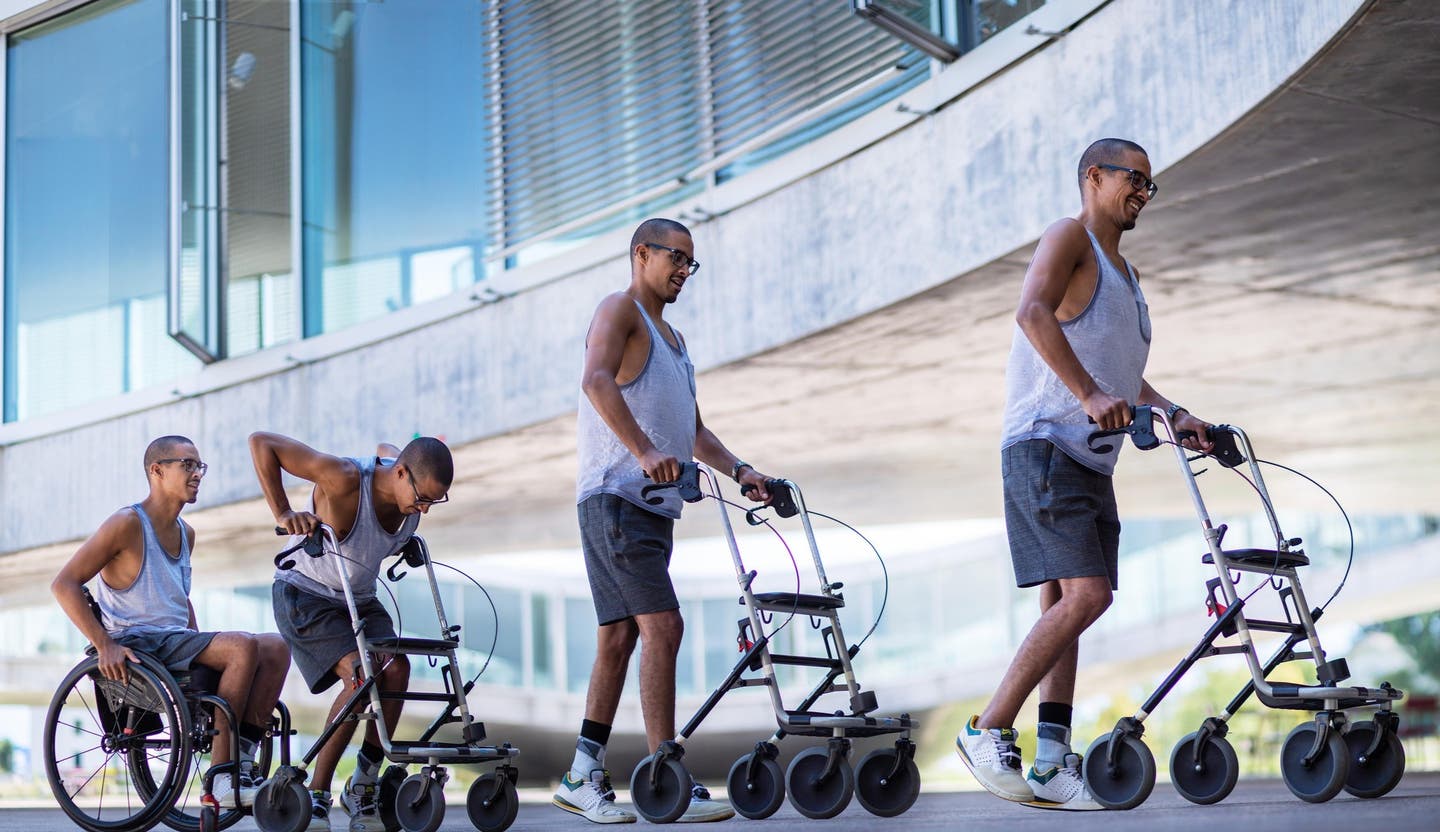First-ever spinal cord implant enables paralyzed people to walk again
Study identified the type of neuron that is activated by spinal cord stimulation, allowing patients to stand up, walk and rebuild muscles.

[Jan. 15, 2023: Emmanuel Barraud, EPFL]
To walk, the brain broadcasts commands through descending pathways that cascade from the brainstem to activate these neurons. (CREDIT: EPFL)
The neurons that orchestrate walking reside in the lumbar spinal cord. To walk, the brain broadcasts commands through descending pathways that cascade from the brainstem to activate these neurons. A severe spinal cord injury (SCI) scatters this exquisitely organized communication system. Whereas the neurons located in the lumbar spinal cord are not directly damaged by the injury, the depletion of essential supraspinal commands renders them nonfunctional. The consequence is permanent paralysis.
Isolated case studies have reported that EES can immediately reactivate nonfunctional neurons in the lumbar spinal cord, enabling people with paralysis to walk. Application of EES during neurorehabilitation (EESREHAB) further improved recovery of walking, even when the stimulation was turned off.
A new study by scientists at the .NeuroRestore research center has identified the type of neuron that is activated and remodeled by spinal cord stimulation, allowing patients to stand up, walk and rebuild their muscles – thus improving their quality of life. This discovery, made in nine patients, marks a fundamental, clinical breakthrough. The study was published today in Nature.
In a multi-year research program coordinated by the two directors of .NeuroRestore – Grégoire Courtine, a neuroscience professor at EPFL, and Jocelyne Bloch, a neurosurgeon at Lausanne University Hospital (CHUV) – patients who had been paralyzed by a spinal cord injury and who underwent targeted epidural electrical stimulation of the area that controls leg movement were able to regain some motor function.
Related Stories
In the new study, not only was the efficacy of this therapy demonstrated in nine patients, but the improved motor function was shown to last in patients after the neurorehabilitation process was completed and when the electrical stimulation was turned off.
This suggested that the nerve fibers used for walking had reorganized. The scientists believe it was crucial to understand exactly how this neuronal reorganization occurs in order to develop more effective treatments and improve the lives of as many patients as possible.
Vsx2 neurons reorganize to restore walking
To arrive at this understanding, the research team first studied the underlying mechanisms in mice. This revealed a surprising property in a family of neurons expressing the Vsx2 gene: while these neurons aren’t necessary for walking in healthy mice, they were essential for the recovery of motor function after spinal cord injury.
This discovery was the culmination of several phases of fundamental research. For the first time, the scientists were able to visualize spinal cord activity of a patient while walking.
This led to an unexpected finding: during the spinal-cord stimulation process, neuronal activity actually decreased during walking. The scientists hypothesized that this was because the neuronal activity was selectively directed towards recovering motor function.
To test their hypothesis, the research team developed advanced molecular technology. “We established the first 3D molecular cartography of the spinal cord,” says Courtine. “Our model let us observe the recovery process with enhanced granularity – at the neuron level.”
Thanks to their highly precise model, the scientists found that spinal cord stimulation activates Vsx2 neurons and that these neurons become increasingly important as the reorganization process unfolds.
Implantable platform for real-time control of epidural electrical stimulation. (CREDIT: EPFL)
A versatile spinal implant
Stéphanie Lacour, a fellow EPFL professor, helped the research team validate their findings with the epidural implants developed in her lab.
Lacour adapted the implants by adding light-emitting diodes that enabled the system to not just stimulate the spinal cord, but also to deactivate the Vsx2 neurons alone through an optogenetic process. When the system was used on mice with a spinal cord injury, the mice stopped walking immediately as a result of the deactivated neurons – but there was no effect on healthy mice.
Single nucleus RNA sequencing of the lumbar spinal cord. (CREDIT: EPFL)
This implies that Vsx2 neurons are both necessary and sufficient for spinal cord stimulation therapies to be effective and lead to neural reorganization.
“It’s essential for neuroscientists to be able to understand the specific role that each neuronal subpopulation plays in a complex activity like walking,” says Bloch. “Our new study, in which nine clinical-trial patients were able to recover some degree of motor function thanks to our implants, is giving us valuable insight into the reorganization process for spinal cord neurons.”
Jordan Squair, who focuses on regenerative therapies within .Neurorestore, adds: “This paves the way to more targeted treatments for paralyzed patients. We can now aim to manipulate these neurons to regenerate the spinal cord.”
Note: Materials provided above by EPFL. Content may be edited for style and length.
Like these kind of feel good stories? Get the Brighter Side of News' newsletter.
Joseph Shavit
Head Science News Writer | Communicating Innovation & Discovery
Based in Los Angeles, Joseph Shavit is an accomplished science journalist, head science news writer and co-founder at The Brighter Side of News, where he translates cutting-edge discoveries into compelling stories for a broad audience. With a strong background spanning science, business, product management, media leadership, and entrepreneurship, Joseph brings a unique perspective to science communication. His expertise allows him to uncover the intersection of technological advancements and market potential, shedding light on how groundbreaking research evolves into transformative products and industries.



